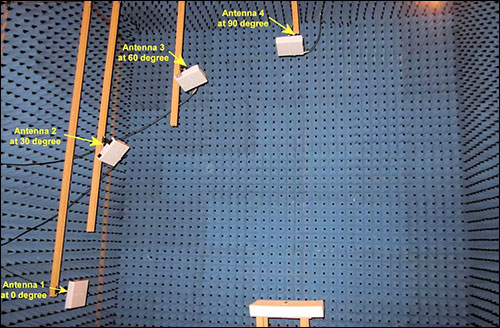Standards group GS1 US has released its Tagged-Item Performance Protocol (TIPP), a guideline that includes a scale for grading the performance of EPC ultrahigh-frequency (UHF) RFID tags when used on specific products and in specific environments, as well standardizing the testing conducted to identify that grade. The TIPP guideline—a set of four documents developed by GS1 US’s Item Level RFID Workgroup—is intended to make it easier for both retailers and suppliers to test and identify the best tag for use with each product and use case. That, predicts Melanie Nuce, GS1 US’s VP of apparel and general merchandise, could pave the way for more universal adoption of item-level RFID tagging of apparel and other goods.
The series consists of the following four documents: TIPP Tagged-Item Grading: Overview provides an overview of the tagged-item grading guideline. TIPP Tagged-Item Grading: Grade Definitions defines the eight total grade specifications. TIPP Tagged-Item Grading: Testing Methodology presents the test procedure and measurement methods to qualify or establish the grade for a tagged item. And TIPP Tagged-Item Grading Testing Configurations defines the orientation for various types of tagged items (which is critical for repeatable testing using the TIPP procedure).

Until now, with no specific standard in place, each retailer has tended to work with its preferred tag and inlay vendors, typically offering several options of specific tag makes and models to the suppliers who tag the products that a retailer buys. The problem with such a system, Nuce explains, is that suppliers sell their products to multiple retailers, each of which has its own favored tag brands. As a result, a supplier may be applying a variety of different tags to its products, depending on the specific retailer receiving those items.
“Tagging at the source helps retailers and suppliers drive true inventory accuracy and visibility to meet the consumer omni-channel promise,” says Bebe Purcell, a co-chair of the TIPP workgroup and a senior analyst at VF Corp., which owns such brands as Lee and Wrangler. “But up until now, suppliers have been challenged with inventory segmentation—as RFID’s performance requirements have been unique from retailer to retailer. With no best practices in place, suppliers have been subjected to undue operational costs and constraints. The TIPP guideline helps alleviate these supplier constrictions by offering the retail sector a methodology to consistently define, test and verify the performance level of EPC-enabled RFID tags.”
The guideline also helps retailers share the results of their testing with others in the industry. In the past, each retailer typically conducted its own testing of tags and readers for its own needs—which, in many cases, has led to duplicative efforts among the many retailers, suppliers and logistics companies that wished to track goods via RFID.
TIPP offers a voluntary standardized system in the form of testing methodology and configurations, as well as grade definitions. If a retailer finds that it requires certain tag-performance specifications for each product, based on the environment in which that product is being read, it can identify a grade (such as Grade S20B) that is assigned to those specifications, and share that information with the supplier, which will then have option to select any tag that meets that grade’s requirements. A list of tags that meet each grade can be found at the ARC website, operated by the Auburn University RFID Lab.
“The guidelines are intended to enable retailers to create their own RFID performance requirements, based on their own use cases,” Nuce says, while suppliers can use the guidelines to gain some flexibility into how they meet a retailer’s requirements.
The workgroup that developed the TIPP guideline includes individuals from several retailers using the technology, such as Macy’s, Kohl’s and Lord and Taylor, in addition to merchandise suppliers including Levi Strauss and Co. and Jockey International. RFID technology companies Avery Dennison, Checkpoint Systems and Smartrac Technology Group, among others, are also members.
The group has been developing the TIPP Guideline throughout the past 18 months, working closely with the Auburn University RFID Lab, which had already developed its ARC method that is used for identifying the best RFID tag for a particular product and environment. ARC provides detailed specifications related to the results of sensitivity and backscatter power testing on a variety of products, in different scenarios (such as hanging on a rack, stacked on a metal or wooden shelf, or moved through a warehouse portal on a forklift), with different types of readers and fixed reader antenna orientations, and with different tag orientations. Companies from around the United States, as well as some in the United Kingdom and Europe, have worked with the Auburn University RFID Lab to learn what specifications are needed for their individual requirements.
The TIPP workgroup has now assigned grades to various specifications from the ARC testing results, explains Justin Patton, the Auburn University RFID Center’s director. A retailer can use the TIPP guideline to simply look up a grade for a specific product category and environment. But in most cases, he adds, it will also utilize the guideline to conduct its own testing first, in order to ensure that a specific grade will meet its requirements. Once the retailer shares that grade with its suppliers, those companies can then use the guideline to conduct their own testing to determine the tags and orientation that will meet the grade requirements.
Therefore, Nuce says, instead of requiring suppliers to apply specific tags to the products it will receive, “the retailer can say, ‘The tag needs to meet these requirements,’ and those requirements are translated into a grade.”
If multiple retailers have different, conflicting grade requirements for a product the supplier sells to them, that supplier can opt to meet the most stringent grade for one retailer, and then use the tag best suited for that grade on the products it sells to all retailers. “It gives the supplier flexibility,” Nuce says.
When it comes to testing a specific tag, the guideline identifies effective processes, such as testing a sample of at least 30 tagged items, and offers criteria for receiving a pass or fail grade. It also indicates what test equipment can be used, and how a “Select” and “Query” command should be employed to capture tag ID numbers via an RFID reader. It breaks down test configurations according to categories that include shorts and skirts, belts, and plastic packaged apparel such as underwear.
The benefits resulting from the TIPP guideline are twofold, Nuce reports. “It will remove barriers for adoption,” she says, by clarifying for both retailers and suppliers how to go about effectively adopting RFID technology. The other gain, she adds, is that TIPP helps foster a collaborative environment “that’s effectively saying ‘we want something that is working for everyone.'”
Patton says he expects the Auburn University RFID Lab to be busier than ever due to the TIPP guideline’s release, since retailers will be conducting testing to determine what specific grade they need for each product in their stores and warehouses. Meanwhile, he adds, suppliers will carry out their own testing to identify the best tags for their products to meet those grades.
The lab has already conducted numerous tests, Patton says, to identify specifications for common use cases and products. “I feel we have a pretty good leg up now as we push this out to a global audience,” he states, explaining that companies beyond North America can benefit from the guideline since the requirements for item-level tagging tend to be the same, with only some frequency differences. “We’re absolutely ready to roll this out globally.”
Further ahead, Patton envisions that retailers will use the TIPP guideline while designing their stores. For instance, a retailer could first decide the RFID tagging grade it would like to assign to EPC-tagged products, and then build the store out to meet that grade. If the retailer plans to stack blue jeans on shelves, for instance, it could design the shelves to encourage high read rates. Wooden shelves, with smaller stacks of jeans, could enable better tag reading than metal shelves with larger stacks, for example.



